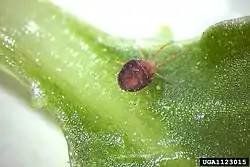壁蝨
See also: 壁虱
Chinese
| wall; rampart | louse | ||
|---|---|---|---|
| trad. (壁蝨/壁虱) | 壁 | 蝨/虱 | |
| simp. (壁虱) | 壁 | 虱 | |
Pronunciation
Synonyms
Japanese
| Kanji in this term | |
|---|---|
| 壁 | 蝨 |
| Grade: S | Hyōgaiji |
| Irregular | |
Etymology 1
/tani/ → /dani/
From Old Japanese. Shift from earlier reading tani.[1][2] This reading persists in some modern dialects.
The kanji spelling is jukujikun (熟字訓), from Chinese 壁蝨. The characters literally mean 壁 (“wall”) + 蝨 (“louse”), as an indication that ticks and mites may be found on walls.
Noun
Usage notes
As with many terms that name organisms, this term is often spelled in katakana, especially in biological contexts, as ダニ.
Derived terms
Derived terms
- 真蜱 (madani): “true dani” → tick
- 毛蜱 (kedani): “hairy dani” → mite
- 葉蜱 (hadani): “leaf dani” → a red mite, a spider mite
- 羽壁蝨 (hadani): “wing dani” → a red mite, a spider mite
- 粉蜱 (konadani): “powder dani” → a mold mite of family Acaridae
Noun
References
- 1988, 国語大辞典(新装版) (Kokugo Dai Jiten, Revised Edition) (in Japanese), Tōkyō: Shogakukan
- 2006, 大辞林 (Daijirin), Third Edition (in Japanese), Tōkyō: Sanseidō, →ISBN
This article is issued from Wiktionary. The text is licensed under Creative Commons - Attribution - Sharealike. Additional terms may apply for the media files.
.jpg.webp)
